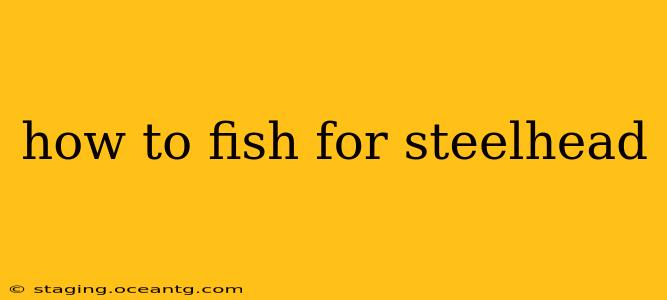Steelhead fishing is a thrilling pursuit, demanding skill, patience, and a deep understanding of this challenging fish. Whether you're a seasoned angler or a newcomer to the sport, this comprehensive guide will equip you with the knowledge and techniques to increase your chances of success. We'll cover everything from choosing the right gear to mastering effective fishing techniques.
What is a Steelhead?
Before we dive into the how-to, let's understand our quarry. Steelhead are anadromous rainbow trout, meaning they live in the ocean but return to freshwater rivers and streams to spawn. This makes their behavior and habitat highly variable, influencing fishing strategies. They are known for their incredible strength and acrobatic jumps, making them a prized catch for anglers worldwide.
Choosing the Right Gear for Steelhead Fishing
Selecting the appropriate gear is crucial for a successful steelhead fishing trip. Here's a breakdown of essential equipment:
Rods:
- Length: 9-12 foot rods are common, offering the necessary reach and power to handle strong currents and powerful fish.
- Action: Medium-heavy to heavy action rods are ideal for steelhead fishing, providing the backbone to set the hook and fight the fish.
- Material: Graphite rods offer sensitivity and strength, making them a popular choice among steelhead anglers.
Reels:
- Size: Large arbor reels (size 7-9) are preferred for their increased line retrieval speed and reduced line twist.
- Type: Spinning or fly reels are both suitable, depending on your chosen fishing method. Spinning reels are generally more versatile for beginners.
Line:
- Type: Braided line is popular due to its sensitivity and strength, but monofilament or fluorocarbon leaders are crucial for stealth and abrasion resistance.
- Weight: Line weight depends on the river conditions and the size of the lures or flies you're using. Generally, 8-15 lb test line is suitable.
Terminal Tackle:
- Leaders: Use fluorocarbon leaders (4-8 lb test) to improve stealth and avoid spooking fish.
- Weights: Sinking weights are often needed to get your lure or fly down to the steelhead's feeding zone, especially in faster currents.
- Hooks: Strong, sharp hooks are essential for secure hooksets and to avoid losing fish. Size and type will depend on your lure or fly choice.
Effective Steelhead Fishing Techniques
Steelhead are opportunistic feeders, and success often hinges on understanding their behavior and adapting your technique accordingly. Here are some popular methods:
Drift Fishing:
This classic technique involves letting your lure or fly drift naturally downstream, mimicking the movement of natural prey. This requires precise casting and the ability to feel the subtle bites.
Swinging Flies:
A popular fly fishing technique, swinging involves mending your line to create a natural drift across the current, allowing the fly to swing through the water column.
Plugging:
Using various types of lures (spoons, spinners, plugs) to entice strikes. This requires understanding water flow and targeting likely holding spots.
Where and When to Fish for Steelhead
Steelhead can be found in a variety of river systems, but their distribution varies depending on the time of year and the specific region. Knowing the timing of their migration and spawning runs is critical for success. Consider factors like water temperature, river flow, and available food sources.
H2: What are the best lures for steelhead fishing?
The "best" lure is highly dependent on river conditions, water clarity, and the steelhead's mood. However, some consistently productive lures include spoons (such as Vibrax or Blue Fox), spinners (like Rooster Tails), and various plugs designed for steelhead fishing. Experimentation is key!
H2: What is the best time of year to fish for steelhead?
Steelhead runs vary by location and river system. However, generally, the best time to fish for steelhead is during their fall and winter runs, when large numbers of fish are migrating upstream to spawn. Spring runs also exist in some areas. Check local fishing regulations and reports for specific timing.
H2: What are some common mistakes when steelhead fishing?
Common mistakes include using improper gear, failing to adjust to changing river conditions, poor casting techniques leading to inaccurate presentations, and not utilizing effective drift techniques. Patience and adaptability are essential!
H2: What are some tips for successful steelhead fishing?
- Learn the river: Understand the water flow, currents, and likely holding spots.
- Be stealthy: Approach the river quietly and avoid making sudden movements.
- Use the right gear: Ensure your equipment is suited to the conditions and techniques you're employing.
- Be patient: Steelhead fishing requires patience. Don't get discouraged if you don't catch one immediately.
- Practice your casting: Accurate casting is essential for success.
- Consult local regulations: Ensure you are aware of and comply with all fishing regulations in your area.
Steelhead fishing is a rewarding but challenging experience. By understanding the fish's behavior, employing the correct techniques, and using appropriate gear, you can significantly increase your chances of landing this magnificent fish. Remember to practice catch and release whenever possible to help preserve this valuable resource.
